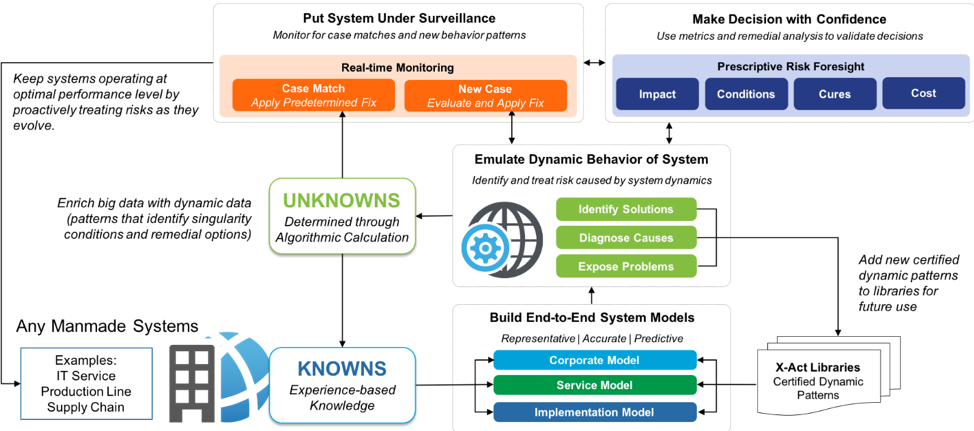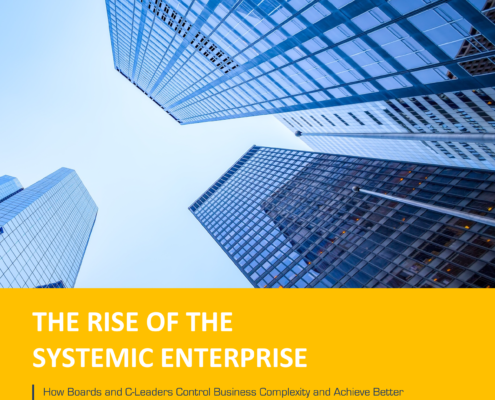The Rise of Systemic Enterprise
The systemic enterprise is an integrated “systems-based” operations management approach that uses mathematical emulation, generative intelligence and automation to model, analyze, and measure operational risk so that system owners can optimally manage the health of business processes and underlying information technology. The systemic enterprise focuses on improving corporate performance by predictively revealing and strategically acting to control the dynamically complex factors that negatively impact system performance, lead to increasing costs or limit agility.
Due to the current rate of disruption, business models, strategies, organizational structure and information systems can quickly become obsolete and risks can quickly evolve. Organizations must maintain visibility across all levels to proactively anticipate and adjust to changing dynamics at the right time.
New mathematical emulation techniques paired with machine learning and automation allow business and government leaders to use advanced predictive capabilities to quantify the impacts of system dynamics and understand with a high level of confidence which actions are needed to meet the organization’s short-term and long-term objectives. In this way, decisions can be taken to help individual divisions meet their goals, while ensuring that the organization also maintains the integrity of interconnected systems or invests when needed in system-wide strengthening.
ALGORITHMS ARE THE SYSTEM MANAGERS OF THE FUTURE
Today’s business systems produce dynamics, which are influenced by external and context dynamics that have grown too complex to be managed based on experience or even with the help of popular business process management (BPM) tools. Business leaders need a quantifiable way to measure the operational risks caused by dynamic complexity, as well as rational and unbiased mechanisms to advance multi-stakeholder, systems thinking in ways that harnesses the technological opportunities of the Fourth Industrial Revolution.
As dynamic complexity continues to evolve and negatively impact critical business systems, the usefulness of human insights and statistical approaches will continue to decline. A systemic and iterative collection of knowledge is the only way to keep pace with the complexity of modern business systems and rate of technological disruption. The algorithmic-based management approach of systemic enterprise empowers leaders with visibility across the boundaries of all business systems so that they can more reliably define and maintain a path to better business results.
When assessing risk, it is clear that some of the data we need will be available using historical information or big data. But some data will be missing because the event has not yet happened and can only be revealed under certain conditions. To expose the missing data, we must use emulation to reproduce the mechanics of various forward-looking scenarios and examine the potential outcomes.
As shown in the figure below, advanced modeling and what-if capabilities can be used to proactively expose evolving risks across business lines, propose new operating and customer models and innovate to better meet dynamic business requirements, cut costs, improve efficiency and take advantage of emerging trends and technologies. Using emulation and advanced analytical capabilities, executives can gain a forward-looking view of the health of interconnected systems, and know when a system transformation or disruption is needed. Any decisions can be justified with accurate knowledge of the benefits, costs and constraints of any proposed change.

Once dynamic complexity is understood and its origins identified, management can move from reactive to a preventive stance. This will become the preferred way to manage risk—identify dynamic complexity, evaluate the risk of degradation and singularities, measure the distance to the risk and take the right actions to avoid negative business outcomes. The right predictive technologies will allow decision makers to evaluate proposed actions prior to implementation, determine the right path to optimization, transformation and/or innovation, and consequently reduce risk without inadvertently adding more dynamic complexity.
Using situational data revealed by the predictive platform, it becomes possible to automate system surveillance to identify cases of increasing risk. These cases are unknowns in big data analytical methods, which are limited to prediction based on data collected through experience. Within the database, a diagnosis definition and remediation that covered both the experience based knowns and those that were previously unknown are stored together to allow for the rapid identification of a potential risk with immediate analysis of root causes and proposed remedial actions.
This approach to right-time risk surveillance, using a database populated by the mathematical predictive platform, represents a real breakthrough that alleviates many of the pains created by the traditional long cycle of risk management, which starts with problem-analysis-diagnosis and ends with an eventual cure well beyond the point of optimal action.
As the database is continuously enriched by the dynamic characteristics that continuously evolve during a system’s lifetime, the knowledge contained within the database becomes more advanced. By continuously recording within the database foundational or circumstantial system changes, the predictive platform will identify any new risk, determine the diagnosis and define the remedial actions, and finally enhance the database with this new knowledge.
In this way, algorithms will help businesses create a defendable advantage—by revealing the factors that may impact performance or limit agility and automatically retuning systems to maintain the highest level of production performance and flexibility to respond to changing business dynamics.
Learn how to leverage the power of algorithms for better performance and agility
The Rise of the Systemic Enterprise white paper explains how businesses are using a systemic enterprise approach to maintain systems that deliver the best performance and agilely respond to constantly changing business requirements.


